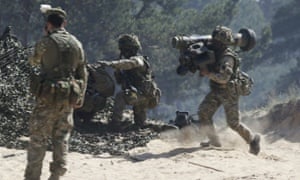
The Polish defence ministry said on Sunday that Washington and Warsaw were in negotiations about the permanent stationing of US battle tanks and other heavy weaponry in Poland and other countries in the region as part of Nato’s plans to develop rapid deployment “Spearhead” forces aimed at deterring Kremlin attempts to destabilise former Soviet bloc countries now entrenched inside Nato and the EU.
Tomasz Siemoniak, the Polish defence minister, had talks on the issue at the Pentagon last month. Warsaw said on Sunday that a decision whether to station heavy US equipment at warehouses in Poland would be taken soon.
Nato’s former supreme commander in Europe, the American admiral James Stavridis, said the decision marked “a very meaningful policy shift”, amid eastern European complaints that western Europe and the US were lukewarm about security guarantees for countries on the frontline with Russia following Vladimir Putin’s seizure of parts of Ukraine.
“It provides a reasonable level of reassurance to jittery allies, although nothing is as good as troops stationed full time on the ground, of course,” the retired admiral told the New York Times.
Nato has been accused of complacency in recent years. The Russian president’s surprise attacks on Ukraine have shocked western military planners into action. An alliance summit in Wales last year agreed quick deployments of Nato forces in Poland and the Baltic states. German mechanised infantry crossed into Poland at the weekend after thousands of Nato forces inaugurated exercises as part of the new buildup in the east.
Wary of antagonising Moscow’s fears of western “encirclement” and feeding its well-oiled propaganda effort, which regularly asserts that Nato agreed at the end of the cold war not to station forces in the former Warsaw Pact countries, Nato has declined to establish permanent bases in the east.
But the rapid deployment strategy provides for constant rotation of western European and US troops in the Baltics and Poland, making the new bases permanent in all but name. The plans also provided for the “pre-positioning” of arms and equipment in the east for use by the arriving forces.
The US planning for heavy weapons goes further. The New York Times said that battle tanks, vehicles and heavy equipment would be adequate for a brigade-strength force of up to 5,000 troops spread among former Soviet satellite states from the Baltic to the Black Sea and numbering up to 1,200 vehicles including 250 M1A2 tanks.
 The three Baltic states – Lithuania,
Latvia and Estonia – Poland, Romania, Bulgaria and Hungary were named
as possible destinations for the US equipment. Most of the host
countries have been clamouring for such signals of US commitment to
their security, but the government of Viktor Orbán in Hungary is
sympathetic to Putin, at odds with Nato, Washington and the EU.
The three Baltic states – Lithuania,
Latvia and Estonia – Poland, Romania, Bulgaria and Hungary were named
as possible destinations for the US equipment. Most of the host
countries have been clamouring for such signals of US commitment to
their security, but the government of Viktor Orbán in Hungary is
sympathetic to Putin, at odds with Nato, Washington and the EU.Lithuania confirmed on Sunday that it was in talks with the US. “The threats to the Baltic region have increased. This has been discussed many times and I view positively [the fact] that talks lead to concrete decisions which, I think, will become a reality,” the Lithuanian prime minister, Algirdas Butkevicius, told Reuters.
Nato defence ministers meet in Brussels next week and the deployments are certain to be discussed. The significant upgrade in US military planning in Europe could trigger unease in Berlin, Paris, Madrid and Rome, sparking worries about militarising the standoff with Putin over Ukraine.
An opinion poll last week showed that western Europeans would not favour military action against Russia if the Kremlin attacked an eastern European ally. Opposition was strongest in Germany.
When signing a post-cold war strategic cooperation pact with Russia in 1997, Nato pledged not to station ground forces permanently in eastern Europe “in the current and foreseeable security environment”. But that environment has been transformed by Putin’s decision to invade and annex parts of Ukraine and the 1997 agreement is now seen as obsolete.
The US plans suggest that the ad hoc moves taken by Nato in response to the Ukraine crisis are hardening into a longer-term and more settled realignment of forces. More than 2,000 troops from nine Nato countries, including the US, embarked on the “Noble Jump” exercises in Poland in recent days as part of the new Spearhead planning.
Δεν υπάρχουν σχόλια:
Δημοσίευση σχολίου